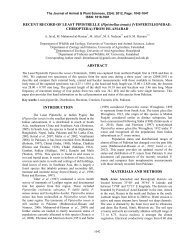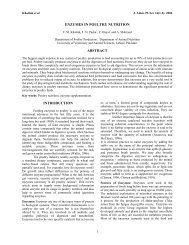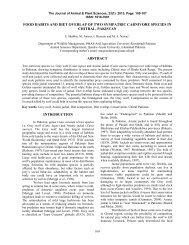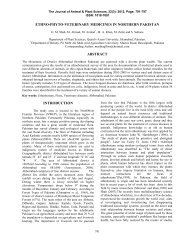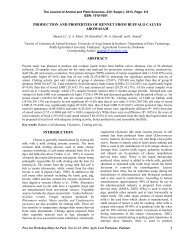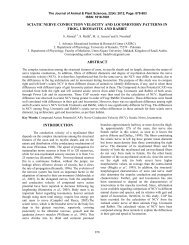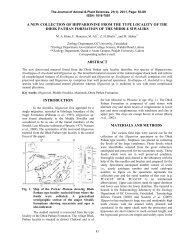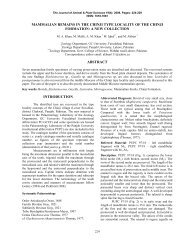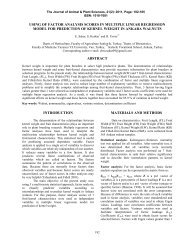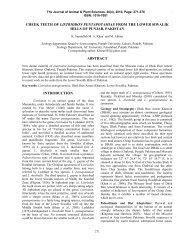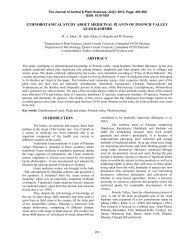taxonomy of some pennate diatoms from kallar kahar lake, district ...
taxonomy of some pennate diatoms from kallar kahar lake, district ...
taxonomy of some pennate diatoms from kallar kahar lake, district ...
You also want an ePaper? Increase the reach of your titles
YUMPU automatically turns print PDFs into web optimized ePapers that Google loves.
Munir et al., J. Anim. Plant Sci. 23(2):2013<br />
General characters: Length <strong>of</strong> cells 26.4 µm, diameter<br />
6.1 µm; striae 26 /10 µm, parallel; Valve area linear or<br />
lanceolate, broad, round ends; band like central area;<br />
raphe straight.<br />
Distribution: Himalaya, Europe, America and Asia<br />
(Japan).<br />
4. Caloneis molaris (Grunow) Krammer (1985), Fig.1<br />
Source <strong>of</strong> Identification: Krammerand Lange-Bertalot<br />
(1997), Table 174, P.793, Fig.21<br />
Synonym: Navicula molaris Grunow Krammer 1863;<br />
Pinnularia molaris (Grunow) Cleve 1995; Caloneis<br />
clevei sensuHustedt 1930<br />
General characters: Length <strong>of</strong> cells 36.1 µm, diameter<br />
7.5 µm; striae 19 /10 µm parallel radiate throughout, at<br />
the ends parallel convergent; valves linear lanceolate;<br />
broad central area, axial area variable, linear to broad<br />
lanceolate.<br />
Distribution: Europe and South-West- Asia (Israel).<br />
5. Caloneis macedonica Hustedt (1945), Fig.4<br />
Source <strong>of</strong> Identification: Krammer and Lange-Bertalot<br />
(1997), Table 175, P .795, Fig.7<br />
General characters: Length <strong>of</strong> cells 36.9 µm, diameter<br />
7.9 µm; striae 22 /10 µm, radiate in middle, convergent at<br />
the ends; valves linear-lanceolate, with protracted<br />
capitate poles; axial area linear, lanceolate, central area<br />
broad.<br />
Distribution: Europe<br />
6. Caloneis undulata (Gregory) Krammer (1985), Fig.5<br />
Source <strong>of</strong> Identification: Krammer and Lange-Bertalot<br />
(1997), Table 176, P. 794, Fig.6<br />
Synonym: Pinnularia undulata Gregory 1854<br />
General characters: Length <strong>of</strong> cells 31 µm, diameter 6.6<br />
µm; striae 22 /10 µm, parallel and radiate in the middle,<br />
convergent at the ends; valve lanceolate, with round ends;<br />
axial area linear, central area broad; raphe filiform.<br />
Distribution: Europe.<br />
9. Haslea R. Simonsen(1974)<br />
Cells solitary and fusiform; valve linear-lanceolate;<br />
striaetrasverse and longitudinal; chloroplast two, plate<br />
like.<br />
Hasleaspicula (Hickie) Lange-Bertalot(1997), Fig.18<br />
Source <strong>of</strong> Identification: Krammerand Lange-Bertalot<br />
(1997),P. 545, Fig. 5<br />
Synonym: Stauroneis spicula Hickie 1874; Navicula<br />
spicula (Hickie) Cleve 1894<br />
462<br />
General characters: Length <strong>of</strong> cells 63.8 µm, diameter<br />
8.8µm; striae /10 µm, radiate, parallel; valves lanceolate<br />
or spindle shape, with round ends; axial area linear.<br />
Distribution: Europe, Australia, America and New<br />
Zealand.<br />
10. Seminavis D.G. Mann (2003)<br />
Cells lanceolate to rhombic lanceolate with rounded ends;<br />
uniseriatestriae; plastidstwo.<br />
Seminavis strigosa (Hustedt) Danielidiset Economou-<br />
Amilliin Danielidis Mann 2003, Fig.7<br />
Basionym: Amphora strigosaHustedt1949<br />
General characters: Cells lanceolate to rhombic<br />
lanceolate with rounded ends; length 26.6µm, diameter<br />
6.0µm; striae 17/ 10 µm.<br />
Distribution: USA: California, Asia: Israel and Thailand.<br />
Acknowledgement: The first two authors thankfully<br />
acknowledge the Higher Education Commission,<br />
Islamabad Pakistan for undertaking this piece <strong>of</strong> work<br />
under HEC Indigenous 5000 Fellowship Program Batch-<br />
VI and International Research Support Initiative Program<br />
(IRSIP). Thanks are due to Dr. R. Jan Stevenson,<br />
Michigan State University, USA for providing laboratory<br />
facilities for algal species identification.<br />
REFERENCES<br />
Abdul-Majeed (1935). Freshwater algae <strong>of</strong> Punjab I.<br />
Bacillariophyta (Diatom eae). Punj. Univ., Publ.<br />
Lahore (Pakistan). 45 p<br />
Hirano, M. (1971). Freshwater algae <strong>of</strong> the North-<br />
Western Himalayas: Reprint: Contributions <strong>from</strong><br />
the Biological Laboratory Kyoto University.<br />
23(2) 81-116.<br />
H<strong>of</strong>mann, G., M. Werum and H. Lange- Bertalot, Edit:<br />
H. Lange- Bertalot (2011). Diatomeenim<br />
Subwasser-Benthos von Mittleuropa. Publisher<br />
Gantner Verlag K. G. 908 p<br />
Husna, R., A. Zarina, Masud-ul-Hasan and M. Shameel<br />
(2007). Taxonomic study <strong>of</strong> <strong>some</strong> <strong>diatoms</strong> <strong>from</strong><br />
Lahore, Pakistan. Int. J. Phycol. Phycochem.<br />
3(1):55-64.<br />
Hussain, F., G. Anjum, M. I. Zaidi and M. A. F. Faridi<br />
(1984). Fresh water algae <strong>of</strong> Hanna Urak Valley<br />
Quetta. Pakistan J. Bot.16(1):81-84.<br />
Krammer, K. and H. Lange-Bertalot(1997a).<br />
Subwasserflora von Mitteleuropa,<br />
Bacillariophyceae: Bacillariaceae,<br />
Epithemiaceae, surirellaceae. Gustav Fisher<br />
Verlag Jena; Berlin.611 p<br />
Krammer, K. and H. Lange-Bertalot (1997b).<br />
Subwasserflora von Mitteleuropa,



